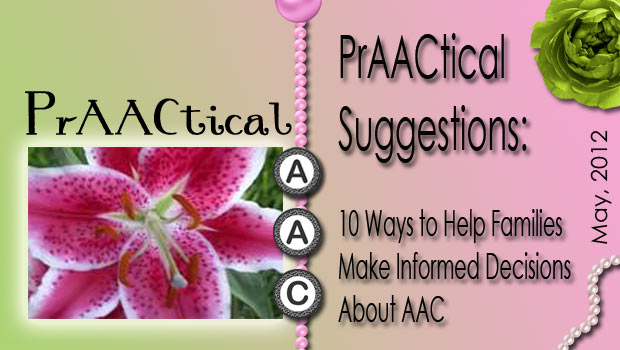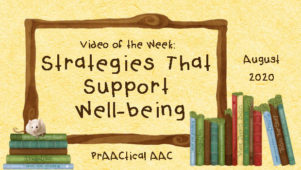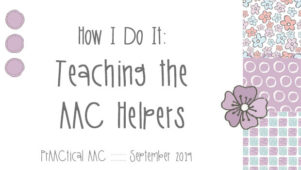PrAACtical Suggestions: 10 Ways To Help Families Make Informed Decisions About AAC

–
In one of my AAC classes, we’ve been talking about how to help families make informed decisions. To do that, they need to have solid information presented clearly, in digestible bites from a trusted source. When we don’t have that information, it is easy to fall prey to fads and/or adopt a herd mentality and do what everyone else is doing. Here are some suggestions for supporting families through the AAC decisions they will need to make.
–
1. Have direct conversations about the pros and cons of the available options. For example, if the family expressed interest in an iPad with AAC apps over a full fledged SGD, then we’d have to be prepared to reiterate the merits and drawbacks of each.
2. Share a process for making AAC decisions rather than attempting to take the decision out of their hands. For example, you may want to encourage them to start by identifying what they want the AAC tool to do for their child. A family who wants their kid to be able to use the device to develop the literate language of a high schooler, for example, will have different benchmarks than the family who is more focused on functional communication and participation in family and community events. Help them clarify what they want, with your guidance, and then encourage them to evaluate each option against THEIR goals for THEIR child.
3. Be crystal clear about your concerns with explicit rationales that make sense to a layperson. I just had to do this with a woman who has ALS and wants to use her iPad over her SGD. She can use both, of course, but I had to make a case for why she should begin to learn to use the big, bulky device. It’s up to me to clearly articulate my concern: If she postpones learning to operate the SGD, it is likely to create a situation in which she will need to learn something new and complex at a time when she’s feeling even weaker and more tired than she is now.
4. Resist the temptation to avoid difficult subjects altogether. As my grandma used to say, if you bury your head in the sand, take notice of what sticks up. Be gentle, of course, but clear and honest when you have to discuss painful or sensitive topics.
5. There is a difference between helping families make informed, collaborative decisions and just doing whatever they want. Yes to the former. No to the latter, if it means that we are acting outside the boundaries of good practice and solid ethics. Families count on us to help them make reasoned decisions. They don’t want to be placated any more than you or I would.
6. If something is not going to be beneficial to the client, then don’t do it. For example, I am occasionally asked to do oral motor exercises with clients who have language and speech delays. When we know the literature does not support a particular treatment for a certain kind of client, we don’t go there. Of course, we have to clearly explain our position to the family or referring SLP. Sometimes it works, and sometimes we just agree to disagree.
7. Be redundant. Share information in different ways, based on what makes most sense for the family with whom you’re working. Some families like to have things in writing, so sharing some written notes, a handout, or even a book chapter or journal article can be helpful.
8. Do a comprehension check. Probe to find out that message you tried to send was received as intended. We’re SLPs. We know communication breakdowns happen frequently. For something as important as decision-making, it’s a good idea to explore this rather than assume you were 100% successful in conveying your thoughts. I wish I had a dollar for every time I thought I was very clear and clearly was not. Better to check out those assumptions while you still have a chance to repair any miscommunications.
9. Accept that you won’t always get the decision you were hoping for. That doesn’t mean you haven’t had an impact. (Anyone who has raised teenagers knows that what you say DOES sink in, but they won’t ‘show’ you that they’re listening. You may not realize they ‘heard’ you for a couple of years.) Sometimes people need to hear something many times before they can accept it or act on it. True for all of us, right? We all know about proper diet and nutrition, for example, but how many of us stay on the perfect path?
10. Always try to leave the door open for more discussion. “You know, Mrs. P., you’ve asked some great questions and we’ve covered a lot of ground today. It’s a lot to process. What if we do this? Let’s each take a couple of days to let it all digest and then we can touch base again on Wednesday. I’m in my office from 2:20-3:00 or we could do it by email. Would that work for you?”
–
We’ve been fortunate to work with and learn from some amazing families over the years and many of these suggestions are the result of those partnerships. How about you? What suggestions can you offer beginning clinicians who are starting their AAC journey?
–
Filed under: PrAACtical Thinking
Tagged With: collaboration, families, FAQs
This post was written by Carole Zangari




